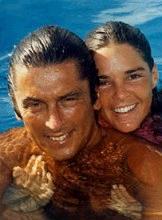The Kid Stays in the Picture


According to Robert Evans, there are three sides to every story; your side, his side, and the truth. To hear him tell his story is so immensely entertaining that no one cares how much is truth and how much is Evans' view of the truth. Either way, Robert Evans is an important part of Hollywood history, mainly from behind the scenes. He was one of the people instrumental in establishing Paramount as a major studio, and was the man behind films like Love Story, The Godfather, Chinatown, and Rosemary's Baby. The Kid Stays in the Picture tracks the meteoric rise and fall of this Hollywood producer, who is still working today.
The first thing to grab the viewer is how the film looks. Directors Nanette Burstein and Brett Morgen (On the Ropes) used a technique to make old photographs seem to come to life. They use computer imaging to take portions of photographs and movie them, in effect giving motion to a static image. Other standard documentary characteristics like excellent archival photographs and footage is here also. The only thing missing is subtitles. The Kid Stays in the Picture is a fascinating look at Hollywood history, but many of the clips and stars shown may not be recognizable by sight. A large number of movies and stars pass across the screen, and it would have helped to have some means of identifying them.
Evans started in business, when Norma Shearer discovered in the pool at the Beverly Hills Hotel. She cast him as Irving Thalberg in Man of a Thousand Faces. Then he appeared in The Sun Also Rises, much to the dismay of basically everybody else on the set (including Ernest Hemingway and Ava Gardner). Yet, director Henry King believed in Evans so much he declared "the kid stays in the picture," which also explains the title of the film. Evans had little further success in front of the camera. He wanted the power of King, so he eventually worked his way into Paramount.
Burstein and Morgen trace his success as he produced hit after hit, and marriage and later divorce to Ali MacGraw. The documentary then enters a darker period, with Evans' addiction to cocaine and eventual tangential involvement in a capital murder case. It was this involvement that led to his largest disgrace. Still, he was able to get back on his feet. Evans' narration is what makes The Kid Stays in the Picture, which is based on his autobiography (adapted by Evans and Morgen). The book did not gain popularity until the books-on-tape version, which Evans narrated. He has an easy style of speaking, a voluminous memory and the instincts of a raconteur. Evans brags freely about his successes and willingly admits and owns up to his mistakes.